PREVIOUS
Bhimrao Ramji Ambedkar - II
May 23 , 2019
2398 days
18737
0
Activism
- In 1924 at Bombay, he established Bahishkrit Hitakarini Sabha for removing difficulties of the untouchables and placing their grievances before government.
- The founding principles of the Sabha were. "Educate, Organize and Agitate"
- He was appointed to the Bombay Presidency Committee to work with the Simon Commission in 1925.
- On 25 December 1927, he led thousands of followers to burn copies of Manu smriti.
- Thus, annually 25 December is celebrated as Manu smriti Dahan Din (Manu smriti Burning Day) by Ambedkarites and Dalits.
- In 20th March 1927, he led a satyagraha in Mahad of Maharashtra to fight for the right of the untouchable community to draw water from the main water tank of the town.
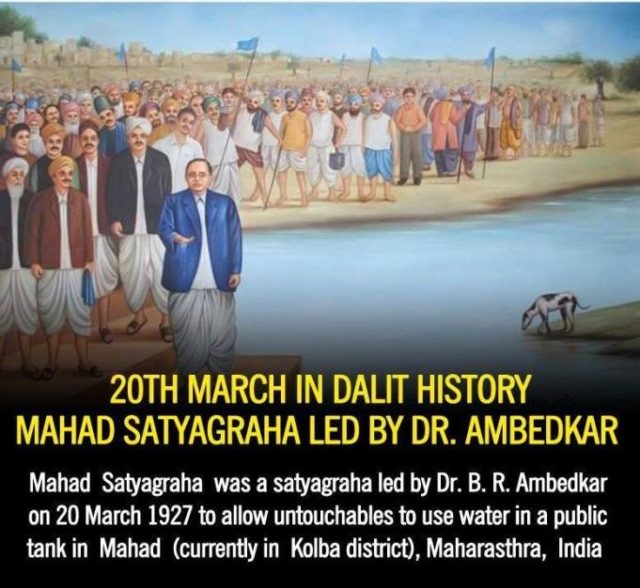
- Thus, Babasaheb was the world's first and only Satyagrahi, who did Satyagraha for drinking water.
- The day (20 March) is being observed as Social Empowerment day in India.
- In 2nd March 1930, Ambedkar launched Kala Ram Temple movement making one of the greatest processions of Nashik.

Poona Pact
- Ambedkar attended all three Round Table Conferences along with Rettaimalai Srinivasan from the then Madras State, who participated in the first two round table conferences.
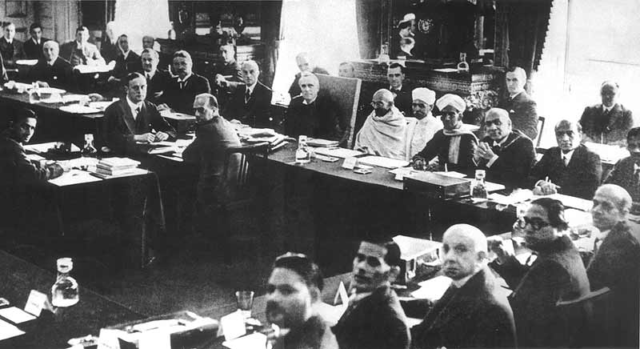
- As a result of the Second Round Table Conference in September 1931, the then British prime minister Ramsay MacDonald on 16 August 1932 announced the formation of a separate electorate for "Depressed Classes" in the Communal Award.
- It provided separate representation for the Forward Caste, Muslims, Buddhists, Sikhs, Indian Christians, Anglo-Indians, Europeans and Scheduled Castes.
- Gandhi fiercely opposed a separate electorate for untouchables, saying he feared that such an arrangement would divide the Hindu community.
- Gandhi protested by fasting unto Death while imprisoned in the Yerawada Central Jail of Poona.
- Following the fast, Congress politicians and activists such as Madan Mohan Malaviya and Palwankar Baloo organized joint meetings with Ambedkar and his supporters at Yerawada.
- On 24 September 1932, the agreement known as Poona Pact was signed between Ambedkar (on behalf of the depressed classes among Hindus) and Madan Mohan Malaviya (on behalf of the other Hindus).
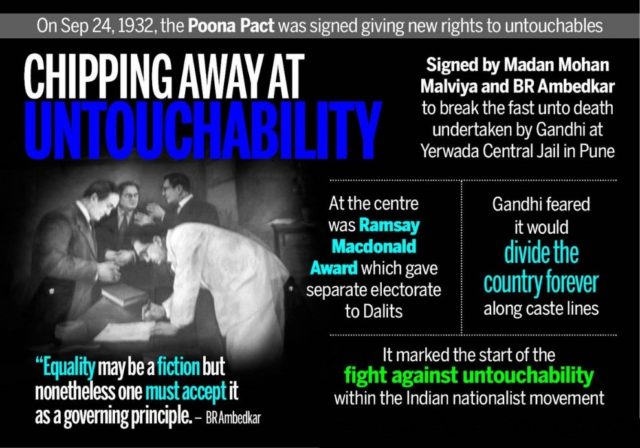
- The agreement gave reserved seats for the depressed classes in the Provisional legislatures, within the general electorate which was also known as Joint Electorate.
- Due to the pact, the depressed class received 148 seats in the legislature, instead of the 71 as allocated in the Communal Award earlier proposed by British Prime Minister Ramsay MacDonald.
- The text uses the term "Depressed Classes" to denote Untouchables among Hindus who were later called Scheduled Castes and Scheduled Tribes under India Act 1935, and the later Indian Constitution of 1950.
In Politics
- In 1936, he founded the Independent Labor Party which won 15 seats in the 1937 Bombay Provincial Elections.
- He served on the Defense Advisory Committee and the Viceroy's Executive Council as minister for Labor during this period (1942–46).
- He brought 8 hours duty in India and change the working time from 12 hours to 8 hours became a light for workers in India.
- He brought it on the 7th session of Indian Labor Conference in New Delhi, November 27, 1942.
- During this period, Babasaheb renamed his party as the Scheduled Castes Federation in 1942 which later evolved into the Republican Party of India in 1956.
- He was initially elected to the Constituent Assembly from Bengal, where Muslim League was in power, but his seat went to Pakistan following the Partition of India.
- He was subsequently elected from the Bombay Presidency in place of a senior jurist Jayakar, ahead of GV Mavlankar.
- Ambedkar had twice become a member of the Parliament of India representing Bombay State in the Rajya Sabha.
- His first term as a Rajya Sabha member was between 3 April 1952 and 2 April 1956.
- His second term was to be held from 3 April 1956 to 2 April 1962, but before the expiry of the term, he died on 6 December 1956.
- Ambedkar contested in the Bombay North first Indian General Election of 1952, but lost to his former assistant and Congress Party candidate Narayan Sadoba Kajrolkar.
- He tried to enter Lok Sabha again in the by-election of 1954 from Bhandara, but he placed third (the Congress Party won).
- By the time of the second general election in 1957, Ambedkar had died.
In Administration
- The Reserve Bank of India (RBI) in 1934 was based on the ideas that Ambedkar presented to the Hilton Young Commission (also known as Royal Commission on Indian Currency and Finance).
- Babasaheb Ambedkar was appointed Chairman of the Constitution Drafting Committee on August 29, 1947.
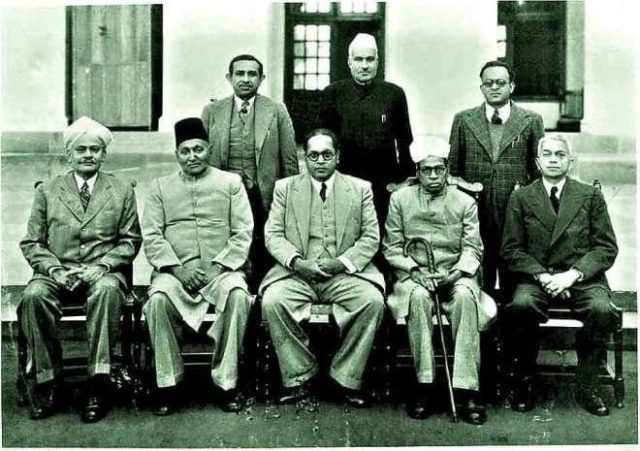
- He was also appointed as the first Union Law Minister in the Cabinet of Jawaharlal Nehru after the Indian Independence in 1947.
- He was also responsible for introducing the Power and Water policy and providing a role to the Union government in the two key sectors.

- He also established the Central Technical Power Board (CTPB) and Central Electricity Authority to explore the potential of and establish hydel and thermal power stations.
- He brought the production of electricity under the control of the government.
- He also established the Central Water Commission to facilitate the development of irrigation projects at both the Central and the state level.
- He also professed the idea of constructing big dams across rivers to prevent floods and widen the irrigation network.
- Damodar Valley Project, the Bhakra Nangal Dam project, the Son River Valley project and Hirakud dam project were his brain child projects.
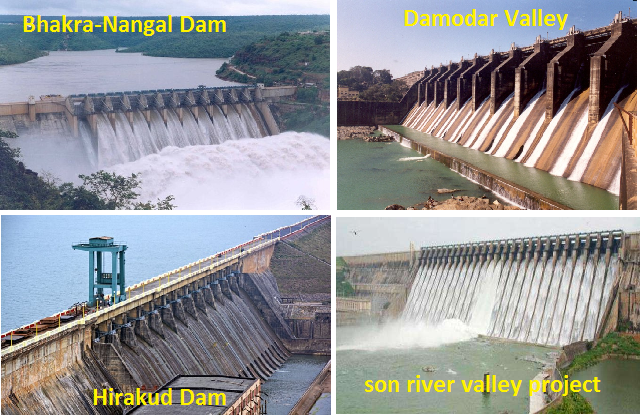
- Ambedkar was the first to suggest the division of Bihar and Madhya Pradesh.
- Ambedkar resigned from the cabinet in 1951, when parliament stalled his draft of the Hindu Code Bill, which sought to enshrine gender equality in the laws of inheritance and marriage.
Later stages
- Ambedkar travelled to Kathmandu of Nepal to attend the Fourth World Buddhist Conference in 1954.
- Buddhist monks there had given Dr. Babasaheb Ambedkar highest title of Buddhism "Bodhisattva".
- Ambedkar founded the Bharatiya Bauddha Mahasabha or the Buddhist Society of India in 1955 at Bombay.
- On October 14, 1956 Ambedkar organized a public ceremony at Nagpur to convert around five lakhs of his supporters to Buddhism.
- Since 1954-55 Ambedkar was suffering from serious health problems including diabetes and weak eyesight.
- On 6 December, 1956 he died on his sleeping at his home in Delhi.
- Since, Ambedkar adopted Buddhism as his religion, a Buddhist-style cremation was organized for him at Dadar Chowpatty beach (Chaitya Bhoomi) in Bombay on 7 December.
- - - - - - - - - - - - - - -
Leave a Reply
Your Comment is awaiting moderation.


